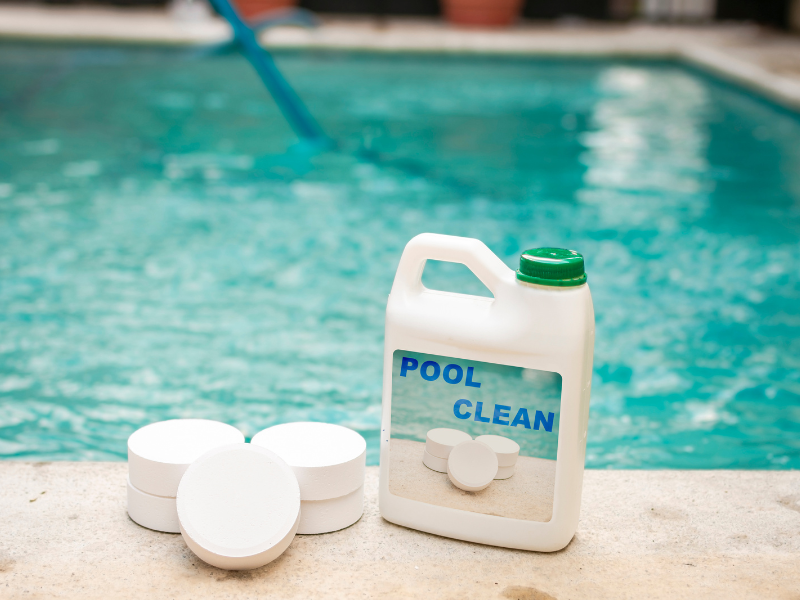The upsides of owning a pool in Winnipeg are obvious – summer dips, backyard pool parties, sunset swims – but those cherished moments are only possible with careful pool maintenance and cleaning.
It doesn’t matter whether you’ve had your pool for years, or just a few weeks, you should know about pool shocking – what it is, how to do it, and when to do it. Overlook this important part of your pool cleaning routine and you could end up with worse problems than murky water.
What is pool shock?
Pool shocking simply means adding chemicals to your pool to raise its free chlorine content so that algae, bacteria, and other contaminants don’t invade the water.
The idea is to raise the chlorine level high enough to remove any built up contaminants that have accumulated in the water over time (like body oils, bacteria, algae) as well as the spent chlorine that is no longer able to sanitize.
There are a few different types of chlorine and it’s important to know which is which to keep your pool at its best. Free chlorine is the chlorine that actively disinfects the water while combined chlorine is the inactive chlorine remaining. The total chlorine number comes from adding the level of free chlorine to combined chlorine.
Shocking your pool is a way of topping up the free chlorine levels so the water remains sanitized.
How to know when to shock your pool
Like everything on your property, pools need regular maintenance. But it’s not always easy to tell when they need some extra TLC. Knowing when to shock your pool can help you avoid problems down the road and extend your pool’s lifespan.
Luckily, there are some red flags to give you a hint that it’s time to treat your pool. Pay attention to the quality of your pool water to catch these early signs of distress:
Look – you can often tell something’s amiss with your pool just by looking at it. If you’re starting to see traces of algae overgrowth, cloudy or murky water, that’s usually a sign that your free chlorine levels have dropped too far and you need to bring the water back into balance.
Smell – when free chlorine combines with organic matter like sweat, oils, or bacteria, it produces substances known as chloramines. These have a very distinct chlorine smell that is apparent when you open up your pool cover or splash around. You might think the chlorine smell is a sign of cleanliness but it’s actually the opposite – chloramines eat up free chlorine, paving the way for algae growth.
Test – one way to know for sure if you need to pool shock is to test your water. If your free chlorine levels are at zero and/or the combined chlorine levels are above 0.5 ppm, it’s time to shock.
Don’t ignore these warning signs, procrastinating on pool maintenance can lead to stinky, even dangerous swimming, and keep you out of the water while you spend time and money repairing the damage.
How to shock a pool
Shocking a pool is as easy as adding chemicals to the water, and these are widely available in a few different forms. All are designed to raise your free chlorine levels safely and without damaging your pool.
Treatments include Calcium Hypochlorite, Lithium Hypochlorite, Dichlor, and liquid chlorine. Most are available in powdered form which needs to be pre-mixed and dissolved before adding to the water, but you can also find liquid pool shock if preferred.
We typically recommend shocking with an oxidizer like using OxyClear, instead of a chlorine-based shock, as it’s gentler and does not affect stabilizer levels in the pool. The only drawback with this approach is that OxyClear will not kill active algae so if your chlorine level has dropped below the ideal range and you suspect there’s something nasty growing in your pool, you should opt for chlorine.
Some owners choose to super chlorinate their water (adding ten times the normal amount of chlorine to kill off chloramines) but we don’t recommend this for several reasons. Firstly it can bleach your pool liner and decrease its lifespan. Secondly, it’s not healthy to swim in highly chlorinated water.
Tips for maintaining your pool shock
As a general rule, you should shock your pool once a week but always test beforehand to see if it’s necessary and bear in mind that the more you use your pool, the more you’ll have to shock it. Heavy rain, pool parties, and accidental spills while enjoying a dip can all throw your chlorine levels off balance.
Keep an eye out for the warning signs of pool shock and follow these tips for guaranteed success:
- Shock your pool at dusk or evening – sun burns off unstable chlorine so it’s best to do your treatment when the sun goes down.
- Don’t use the pool immediately after treatment – wait until free chlorine levels drop to 1-3 ppm.
- Practice safe cleaning – no matter which product you use, always read the instructions carefully and, if in doubt, consult a pool expert for guidance. And don’t forget to wear gloves and goggles when applying treatment.
Winnipeg-based UV Pools is your one-stop-shop for pool repairs and replacements. Our expert team helps pool owners keep their pools in top shape – assessing leaks, carrying out repairs, and installing replacement liners. We take the stress out of pool maintenance with service you can rely on. Contact our team today to request a free quote.

